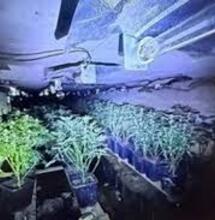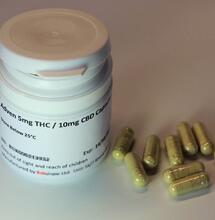When to harvest outdoor cannabis plants

Growing cannabis outdoors can be very rewarding. It is much cheaper than growing indoors, and it will also bring you huge plants, with heavy yields. But like anything when growing cannabis, it has its pros and cons. When you grow outdoors, you have much less control over the environment your plants live in, then when you grow indoors.
As the autumn months approach, the temperatures will fall. This is not only detrimental to the growth of the plant, but as temperatures fall, mould spores can germinate, and bud rot can set it. Some cannabis strains, have a long flowering period, and may not be harvested until mid-November (Northern Hemisphere). By this time, temperatures are usually too cold for a cannabis plant to thrive, and the risk of mould is very high.
You have to be able to judge whether your plant is ready for harvest, and if not, is it worth risking more time outdoors, or should it be harvest early. Here we will discuss the best ways to decide whether your outdoor cannabis plant is ready for harvest.
When to Harvest Outdoor Cannabis Plants
The actual time you will harvest an outdoor cannabis plant will depend on a few things:
• Flowering time of the strain
• The Maturity of the Trichomes
• Environmental Conditions
It is always best, to allow your plant the time it needs to fully mature and ripen before harvesting. Harvesting at the right time will increase yield, potency and terpene content. Giving you a better high, medicinal relief, a better flavour and more cannabis.
But because you do not have much control over the environment, leaving a cannabis plant outdoors to fully mature can be risky with some strains. Some cannabis strains will flower into late autumn. It is important to consider the flowering time of your strain, before you grow it.
If you live in colder climates, then try choosing a strain with a short flowering cycle, like an auto flowering plant or an Indica dominant strain. These will be more likely to finished before it gets too cold and wet.
Check the Flowering Time
If you know what strain you are growing, and what breeder it comes from, you will be able to find out when the best time for harvesting outdoors is.
The breeders estimated harvest date is just that, an estimate. Though it can give you an idea of when your plant will be finished, there are too many variables that need to be taken into account, and each grow is different.
Indica dominant strain will have a shorter flowering period than sativa dominant strains, so they will be harvested earlier. Some Sativa strains will flower for 16 weeks, and can push into 20 weeks of flower before you start to see amber trichomes.
In some cases, you may not have any information from the breeder. This can make it tough to estimate when the peak harvest time is. For best results, and accurate reading, you should check the trichomes on the buds of your plant, to see how mature they are before harvesting.
Maturity of The Trichomes
One of the best ways to tell if your cannabis plant is ready for harvest is by checking the trichomes on the buds. Judging by their appearance, you can tell if they are mature, at peak, or starting to degrade.
Choosing the right time to harvest will improve the quality and yield of your cannabis. You must always try to harvest your outdoor cannabis plant with at least, 90% milky trichomes, with 10% clear.
To do this, you need to use a USB microscope or a Jewlers Loupe, ( 1 ) to take a close look at the crystals on the buds of the plant ( 2 ).
When there is over 90% milky trichomes, it is close to harvest time. Harvest somewhere around 90% Milky, and10% amber ( 3 )
Clear Trichomes: When the trichomes are clear, it means they are immature, and your plant is not ready for harvest. The plant still has more time to gain weight, and produce more resins and terpenes. Harvesting now will be detrimental to your final yield, flavour and quality.
Milky Trichomes: If you are seeing a large amount (over 90%) of milky trichomes on your buds, the plant is approaching harvest time. It is at this point that trichomes production has reached its peak, and they will start to degrade from here.
Harvesting a cannabis plant with all milky trichomes will give you a good clean high, that expresses the characteristics of the strain you’re growing. Many growers will harvest around this time, especially for outdoor growers who live in cold and wet climates.
Amber Trichomes: Having amber trichomes on your buds, will bring you a heavy, couchlock kind of high. For best results, many growers will look for between 10% and 20% amber trichomes before harvest. This gives the user a nice balance of milky and amber trichomes with very few clear, and leaves them with a nice head high, with a little body stone to go with it.
Bear in mind, some auto flowering strains, or Sativa dominant strains, may not show amber trichomes for a long time. So, if you are growing outdoors, be ready for harvest when you see at least 90% of your trichomes have turned milky.
If the conditions allow, let the plant go for a little longer, and try to get to 10% amber before harvesting. This may take an extra couple of weeks, so be careful with the changes in the weather, and decide carefully when to harvest.
Environmental Conditions
When growing cannabis outdoors, controlling the environment that your plants live in can be difficult. Because of this, it is important to be aware of the seasons changing, and the fall in temperatures.
Cannabis plants grown outdoors will usually be harvested between mid-September, to mid-November, in the Northern Hemisphere, and mid-March and May for the Southern Hemisphere. The length of the flowering period will differ, depending on the strain you are growing.
If you are growing auto flowering cannabis plants outdoors, you should follow the breeder's timeline from germination to harvest. You should also check the trichomes, and harvest at 90-100% milky.
In some countries, the Autumn weather can be too harsh for cannabis plants. Humidity is high, and temperatures are low. This can be an ideal environment for mould spores to germinate, and start to infect your buds.
Because you cannot control the environment as much as you would like to, you have to be vigilant, and keep an eye open for any signs of mould or rot forming on your buds.
If you do find any rot or mould, it will need to be removed, and thrown away! Mouldy buds should never be consumed!
To reduce the chances of rot and mould infecting your plants, harvesting a little early is on option. Check the trichomes and decide whether the plant is mature enough for harvest (90% milky 10% Clear at least), or if it will need a little longer. You should try to push for around 10% amber trichomes with 90% milky before harvesting, but not at the risk of losing the crop to rot!
Bud Rot and Mould
You should try to allow your plant to reach its peak, by waiting until at least 90% of the trichomes on the buds are milky. If you harvest before this stage, the quality, and yield, of your cannabis will be reduced. You should wait a little longer to get the best results.
Unfortunately, to do this, you increase the risk of finding rot and mould. As mentioned earlier, some strains will not be harvested until mid-November, and condition are not always ideal for your plants at this time of year.
To reduce the chances of your plants being infected by rot and mould, so you can try and reach the optimal harvest time, there are a few precautions you can take.
Good Airflow Around the Plant
Bud rot, is also known as Grey Mould. It will develop from mould spores that are on your plants and buds. These spores are everywhere, but they will not germinate until conditions are right. This is when bud rot becomes a problem.
Mould spores will grow best in stale pockets of air with warm 22 to 32 °C temperatures, and high humidity. So, one of the best ways to combat it, is to ensure your plants have a good supply of fresh air around it at all times.
This can be done by having a fan blowing at the plants, (which is not always possible when growing outdoors) or by removing some leaves, and any equipment or objects that may be restricting the airflow.
If you can keep a constant supply of fresh air to the plants, you are less likely to see bud rot.
Keep the Plant Dry
Along with stale air and warm temperatures, high humidity and moisture will also encourage the growth of mould spores.
If possible, you should try and cover your plant so rain will not fall onto it during these later stages of flower. If the buds get wet, and cold, they will start to rot and go mouldy.
Air flow is important here too, even if the plant does get wet, with enough breeze, the moisture will evaporate off the plants. But if the breeze cannot reach a certain part of the plant, mould is likely to grow there.
So, if you would like to push your outdoor plant a little further this season, ensure they have good airflow around them, keep a close eye on humidity levels, but don’t be afraid to harvest a little early if you need to.
Harvesting Your Plant at the Right time
Taking all of this into consideration, you can now decide when is the best harvest time for your outdoor cannabis plants.
Check the trichomes, and aim for at least 90% milky, with a touch of amber if you can. If temperature and humidity start to become a problem, then you may have to harvest early to prevent the crop being lost to rot and mould. Only you can make this decision.
If at any time, the temperatures fall too far, and you’re worried about mould setting in, as long as the trichomes are over 90% milky, you can harvest with good results.
In the case that you do find mould or rot on any of the flowers on your plants, you must not use them! Not even for extracts. Ingesting mould spores can be very dangerous and bad for your health. Throw any infected buds away, and consider harvesting as soon as possible, before more rot sets in.
To summarize
Finding the right time to harvest your outdoor cannabis plant is not easy. The further you head into autumn, the more chances you have of your plant contracting mould.
At the same time, you do not want to harvest early, and sacrifice the quality of the final product. It’s a fine balance, and it is your plant, you have to decide what is best for you.
As long as over 90% of the trichomes are milky, you can chop the plant with great results. Try to go for a little longer if you can, but not at the risk of losing the crop to rot.
Good luck, and enjoy your harvest!



